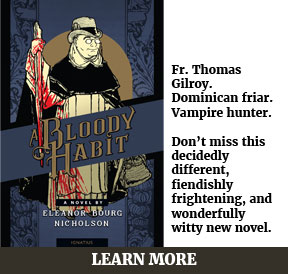
“Oh, is that an allusion to the Fall?”
“The what?”
“The Fall of Adam and Eve.”
“Uh, no.”
“Is it Persephone in the underworld?”
“Who?”
It was around ten years ago. I was at an open studio event held in a huge old warehouse in the SOMA neighborhood of San Francisco. Several painters and sculptors were exhibiting their work, ranging from intentionally incomprehensible prints of layered graphics to a city made from candy to a number of rather good paintings. I was looking at one depicting a darkened landscape with a figure of a woman accepting a red fruit from a shadowy man in a robe. The artist was standing nearby, so I asked him about it. After a number of back and forth comments he shrugged and told me he had seen something similar in a painting somewhere and decided to riff on it. It wasn’t intended to be Eve’s encounter with Satan or Persephone being tricked by Hades, it was just an image that resonated with him.
Since then I’ve noticed this happening in other mediums: film or literature or music. As more and more people drift from a firm education in the classics, the images live on after their original context is lost. For every artist like John Darnielle of the band the Mountain Goats, a man who knows literature and scripture inside and out and uses this knowledge to great effect, there’s a dozen others who pick and grab bits and pieces of imagery and words from the artists they enjoy. They don’t really know why these words and images are powerful, they just know that they are. So they use them, and sometimes they can create powerful works like the painting I described above. But it’s a second-hand sort of knowledge.
A while back the satirical newspaper The Onion featured the headline “Unconventional Director Sets Shakespeare Play In Time, Place Shakespeare Intended”. It’s more groan-worthy than hilarious, but a lot of satire generates more winces than guffaws. What makes riffing on a classic subject or image work is a widespread appreciation and knowledge of the source. “That’s Opera, Doc” and “The Rabbit of Seville” are hilarious even without knowing the works of Mozart or Wagner, but you get more out of it if you’ve encountered the operas being referenced first. A book like Jonathan Strange & Mr Norrell is a fun read, even more so if you’re familiar with the Regency-era literature that it’s a pastiche of. The more one delves into the classics, the more depth you can get out of art and the more depth you can put into the creation of it. But when we’ve lost the source material and are relying only on the riffs, that’s when things start to drift.
So keep on riffing and referencing the classics. But make sure you get some grounding. At the risk of turning commercial here (after all, this is a publisher’s blog), one place to start is with the Ignatius Critical Editions. From Shakespeare to Boethius to Dickens, this series has been steadily producing editions of the classics that eschew imposing modern interpretations of texts and instead try to give the reader an appreciation for the source material on its own terms. Also, I’m the designer for the covers in this series, and designing them has been a lot of fun. So let me make a selfish plea: if you keep buying them, I get to keep designing them!
Scripture too is a rich, rich source for artistic depth. One of the most popular titles Ignatius Press published in the past year is the Didache Bible, Ignatius Edition. Or you can take a look at the free Ignatius Study Bible App, which gives you the complete text of the Bible along with a number of extra features.
Make use of your local art institutions. Museums, galleries, movie theaters devoted to showing classics, the local symphony or opera company: all of them depend on people who are interested in art. Your local library probably has a collection operas and ballets on DVD.
The more your artistic vocabulary has firm grounding, the more you’ll appreciate every form of art. Call it the “One Weird Trick to Appreciate Art”.






carleolson
May 20, 2015 at 8:24 pm
Ah, this brings back memories from two years in art school. I recall that many of my fellow students—most of them modestly talented, at best—all wanted to make a Big Statement. About Something. Somehow. But they lacked the means to do so, both artistically and culturally. I wasn’t really much different, I must say; I’m thankful that becoming Catholic has expanded my understanding of great art and the meaning behind it.
michaelnicholasrichard
May 22, 2015 at 8:51 am
Kudos for the “One weird trick” angle. It made me laugh. You followed it up with much more substance than usually follows a “one weird trick” opening.
John Herreid
May 22, 2015 at 11:41 am
Thanks!